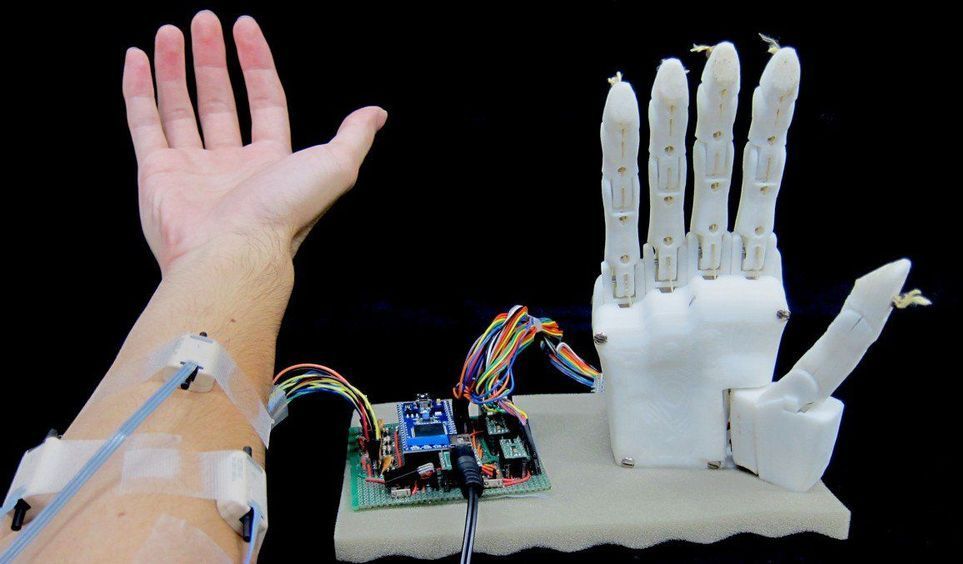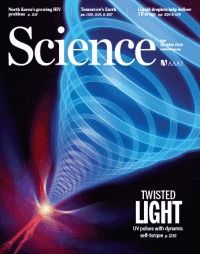On June 27, 2019, NASA announced a new mission to Saturn’s moon Titan featuring a rotorcraft lander. — Mission was proposed in 2017: https://www.space.com/36598-dragonfly-quadcopter-saturn-moon-titan-explorer.html
Credit: NASA
On June 27, 2019, NASA announced a new mission to Saturn’s moon Titan featuring a rotorcraft lander. — Mission was proposed in 2017: https://www.space.com/36598-dragonfly-quadcopter-saturn-moon-titan-explorer.html
Credit: NASA


A 3D-printed prosthetic hand controlled using a new AI-based approach could significantly lower the cost of bionic limbs for amputees.
Real need: There are approximately 540,000 upper-limb amputees in the United States, but sophisticated “myoelectric” prosthetics, controlled by muscle contractions, are still very expensive. Such devices cost between $25,000 and $75,000 (not including maintenance and repair), and they can be difficult to use because it is hard for software to distinguish between different muscle flexes.
Handy invention: Researchers in Japan came up with a cheaper, smarter myoelectric device. Their five-fingered, 3D-printed hand is controlled using a neural network trained to recognize combined signals—or, as they call them, “muscle synergies.” Details of the bionic hand are published today in the journal Science Robotics.
Magnetic actuation of keyboards can have almost an infinite number of keystrokes.
The ultimate entry-level gaming keyboard featuring individually programmable backlit keys Powered by Razer Chroma for full personalization and performance.

Scientists from Sanford Burnham Prebys have created natural-looking hair that grows through the skin using human induced pluripotent stem cells (iPSCs), a major scientific achievement that could revolutionize the hair growth industry. The findings were presented today at the annual meeting of the International Society for Stem Cell Research (ISSCR) and received a Merit Award. A newly formed company, Stemson Therapeutics, has licensed the technology.
More than 80 million men, women and children in the United States experience hair loss. Genetics, aging, childbirth, cancer treatment, burn injuries and medical disorders such as alopecia can cause the condition. Hair loss is often associated with emotional distress that can reduce quality of life and lead to anxiety and depression.
“Our new protocol described today overcomes key technological challenges that kept our discovery from real-world use,” says Alexey Terskikh, Ph.D., an associate professor in Sanford Burnham Prebys’ Development, Aging and Regeneration Program and the co-founder and chief scientific officer of Stemson Therapeutics. “Now we have a robust, highly controlled method for generating natural-looking hair that grows through the skin using an unlimited source of human iPSC-derived dermal papilla cells. This is a critical breakthrough in the development of cell-based hair-loss therapies and the regenerative medicine field.”

Physicists at the National Institute of Standards and Technology (NIST) have teleported a computer circuit instruction known as a quantum logic operation between two separated ions (electrically charged atoms), showcasing how quantum computer programs could carry out tasks in future large-scale quantum networks.
Quantum teleportation transfers data from one quantum system (such as an ion) to another (such as a second ion), even if the two are completely isolated from each other, like two books in the basements of separate buildings. In this real-life form of teleportation, only quantum information, not matter, is transported, as opposed to the Star Trek version of “beaming” entire human beings from, say, a spaceship to a planet.
Teleportation of quantum data has been demonstrated previously with ions and a variety of other quantum systems. But the new work is the first to teleport a complete quantum logic operation using ions, a leading candidate for the architecture of future quantum computers. The experiments are described in the May 31 issue of Science.

Circa 2001
DNA methylation is a major epigenetic modification of the genome that regulates crucial aspects of its function. Genomic methylation patterns in somatic differentiated cells are generally stable and heritable. However, in mammals there are at least two developmental periods—in germ cells and in preimplantation embryos—in which methylation patterns are reprogrammed genome wide, generating cells with a broad developmental potential. Epigenetic reprogramming in germ cells is critical for imprinting; reprogramming in early embryos also affects imprinting. Reprogramming is likely to have a crucial role in establishing nuclear totipotency in normal development and in cloned animals, and in the erasure of acquired epigenetic information. A role of reprogramming in stem cell differentiation is also envisaged.
DNA methylation is one of the best-studied epigenetic modifications of DNA in all unicellular and multicellular organisms. In mammals and other vertebrates, methylation occurs predominantly at the symmetrical dinucleotide CpG (1–4). Symmetrical methylation and the discovery of a DNA methyltransferase that prefers a hemimethylated substrate, Dnmt1 , suggested a mechanism by which specific patterns of methylation in the genome could be maintained. Patterns imposed on the genome at defined developmental time points in precursor cells could be maintained by Dnmt1, and would lead to predetermined programs of gene expression during development in descendants of the precursor cells (5, 6). This provided a means to explain how patterns of differentiation could be maintained by populations of cells. In addition, specific demethylation events in differentiated tissues could then lead to further changes in gene expression as needed.
Neat and convincing as this model is, it is still largely unsubstantiated. While effects of methylation on expression of specific genes, particularly imprinted ones and some retrotransposons , have been demonstrated in vivo, it is still unclear whether or not methylation is involved in the control of gene expression during normal development (9–13). Although enzymes have been identified that can methylate DNA de novo (Dnmt3a and Dnmt3b) (14), it is unknown how specific patterns of methylation are established in the genome. Mechanisms for active demethylation have been suggested, but no enzymes have been identified that carry out this function in vivo (15–17). Genomewide alterations in methylation—brought about, for example, by knockouts of the methylase genes—result in embryo lethality or developmental defects, but the basis for abnormal development still remains to be discovered (7, 14).


After twenty five years of research, scientists at the Massachusetts Institute of Technology think that they have finally cracked the code for the commercialization for nuclear fusion reactions.
Commonwealth Fusion Systems is the fruit of that research. It’s a startup building on decades of research and development that plans to harness the power of the sun to create a cleaner, stable source of energy for consumers. And the company just raised another $50 million in funding from some of the country’s deepest pocketed private investors to continue on its path to commercialization.
The company unveiled its technology and a first $64 million in financing from investors including the Italian energy company, Eni; Breakthrough Energy Ventures, the investment consortium established by the world’s richest men and women, and The Engine, MIT’s own investment vehicle for frontier technologies.
Photography measures how much light of different color hits the photographic film. However, light is also a wave, and is therefore characterized by the phase. Phase specifies the position of a point within the wave cycle and correlates to depth of information, meaning that recording the phase of light scattered by an object can retrieve its full 3D shape, which cannot be obtained with a simple photograph. This is the basis of optical holography, popularized by fancy holograms in sci-fi movies like Star Wars.
But the problem is that the spatial resolution of the photo/hologram is limited by the wavelength of light, around or just-below 1 μm (0.001 mm). That’s fine for macroscopic objects, but it starts to fail when entering the realm of nanotechnology.
Now researchers from Fabrizio Carbone’s lab at EPFL have developed a method to see how light behaves on tiniest scale, well beyond wavelength limitations. The researchers used the most unusual photographic media: freely propagating electrons. Used in their ultrafast electron microscope, the method can encode quantum information in a holographic light pattern trapped in a nanostructure, and is based on an exotic aspect of electron and light interaction.